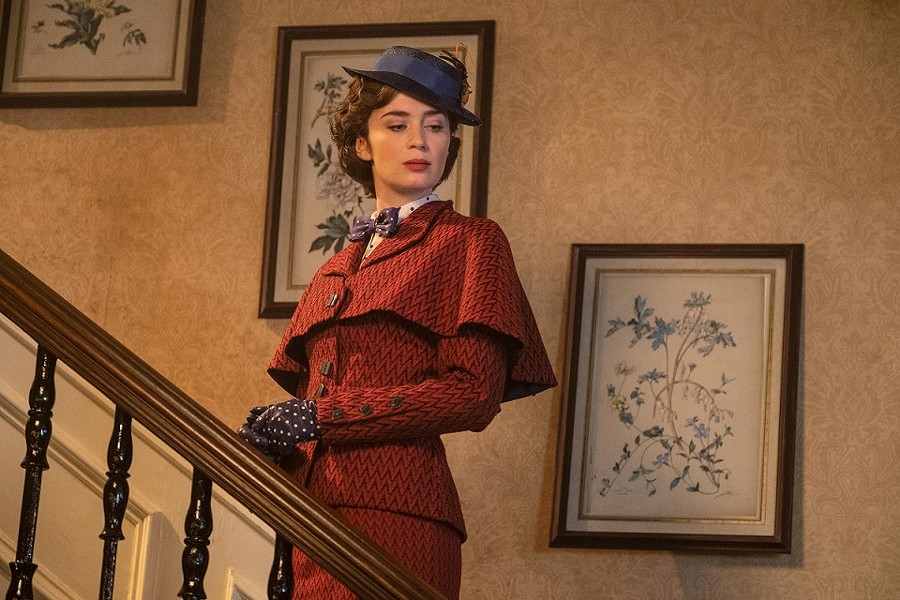Any follow-up to "Mary Poppins," the classic 1964 live-action Disney film inspired by the P. L. Travers book series, already has a lot working against it. Even if the author herself was never as thrilled with Disney's adaptation as audiences were, it's a beloved piece of pop culture history. Pitching itself somewhere between a remake and a sequel, "Mary Poppins Returns" doesn't desecrate the original's legacy, but it doesn't fully distinguish itself either, charming as it is.
Set in depression-era London, the film finds Mary Poppins (played by Emily Blunt) returning to the Banks family 25 years after she last left them. Ben Whishaw and Emily Mortimer play Michael and Jane, the now grown-up Banks children. Michael now has three children of his own, Anabel, John, and Georgie (Pixie Davies, Nathanael Saleh, and Joel Dawson).
Their mother has recently passed away, and the family is in danger of losing their home as Michael has begun to struggle financially, and been unable to pay off his loan on the house. Now the new president of the Fidelity Fiduciary Bank, William "Weatherall" Wilkins Jr. (Colin Firth), has come to collect. Along comes the prim and proper nanny with quasi-magical powers to help save the day.
"Mary Poppins Returns" is at its heart a whimsical ode to the power of imagination. Mary Poppins has the ability to appear in their lives of a family precisely when she's needed most. Her methods are unorthodox: She throws a bit of absurdity at the family, adjusts their way of thinking by a hair, and that somehow makes all the difference.
Blunt has some major shoes to fill in Julie Andrews' iconic, Oscar-winning portrayal. Smartly, the actress never attempts to replicate Andrews' performance, which would have been a recipe for disaster. Her Mary is mysterious, and she captures the character's ever so slightly sinister qualities in a way that distinguishes it from Andrews' interpretation. Reuniting with her "Into the Woods" director Rob Marshall, Blunt's performance is practically perfect in every way, and the best part of the film.
Along for the ride is "Hamilton" mastermind Lin-Manuel Miranda, playing an old friend of Mary's, a scruffy lamplighter named Jack. Probably due to Miranda's fame, his character has been given a lot more to do compared to Dick Van Dyke's comparable character in the first film. And while you don't get much more charming when it comes to performers, Marshall leans heavily on reaction shots from Miranda to tell us when we're supposed to be enchanted by what we're seeing.
As a film, "Mary Poppins Returns" is proudly old-fashioned, an attempt to replicate the distinctive look and feel of the backlot family musicals of the mid-1960s. Aside from brand-new music composed by Marc Shaiman with songs written by Scott Wittman and Shaiman, it sticks to tried-and-true formula, following the template of the original film pretty much exactly. Its story follows the same exact structure and basic beats, though the details have changed slightly.
There's still a sequence blending live-action and animation; in the original, Mary and the children are transported to the animated world after jumping into a sidewalk painting, here they leap into the art decorating a porcelain bowl. This escapade does give us the film's most delightful number, "A Cover Is Not The Book." Particularly during this section, the film's production design, art direction, and the great Sandy Powell's impeccable costumes are truly stunning.
It also concludes with a chase sequence that feels like the film spinning its wheels, and possibly the result of studio notes requesting more action in the story. It's also oddly dark in tone considering the film that surrounds it. It is, however, an undeniably treat to see hand-drawn 2D animation in a Disney film again.
Marshall continues to be a fine director, though not much more. Even after sixteen years of directing musicals for film, he still cuts elaborate production numbers within an inch of their lives.
It's possible he's cutting around his leads, who might not be the best dancers, but the ensemble dancers are clearly top notch, and some wider shots would have allowed the audience to better appreciate the intricate choreography. The film has its dull spells and, much like the first film, most of what little plot there is revolves around the ins-and-outs of the British banking system.
It's a little disappointing that Disney decided to play so safe, but on the plus side, I do feel an enormous amount of gratitude to the writers for not attempting to shoehorn in a dramatic backstory for Mary Poppins. Because if there's one thing that Mary Poppins doesn't need, it's to be explained. There's a lot to like about "Mary Poppins Returns" (and much of it is genuinely delightful) but in relying so heavily on the audience's fond memories of the original, beyond Emily Blunt's fantastic performance, Marshall's film never reveals a unique magic of its own.
